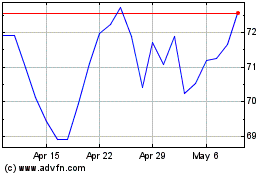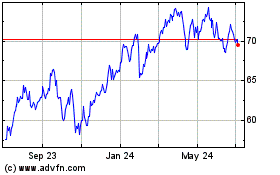MetLife Discloses Failure to Pay Thousands of Workers' Pensions
December 15 2017 - 7:09PM
Dow Jones News
By Leslie Scism
MetLife Inc. said Friday it had failed to pay monthly pension
benefits to possibly tens of thousands of workers in accounts that
it has on its books as part of its large retirement business.
The New York insurer said it is seeking to find the retirees who
are owed money, and who generally have average benefits of less
than $150 a month. It said it believes the group represents less
than 5% of about 600,000 people who receive certain benefits from
the firm.
The discovery of the overdue money and the process of locating
the missing people to pay them would require strengthening
reserves, MetLife said in a filing. The company also said the
amount "may be material to our results of operations."
The workers impacted by Friday's disclosure were likely owed a
defined amount of monthly income when MetLife took on
responsibility for their pensions from their employers, under a
booming business known as "pension risk transfer." MetLife didn't
say in what years it had acquired these particular pension plans,
how many different plans the people were involved, and how many
years of missing income was owed.
Some Wall Street analysts assumed that the payments could be 10
or more years overdue. At $150 a month for 30,000 people -- 5% of
the 600,000 -- over 10 years, that could be up to $540 million.
Analyst Thomas Gallagher of Evercore ISI estimated that the
fourth-quarter charge against earning would be in the $200 million
to $400 million pretax range.
Another analyst, Jay Gelb of Barclays, estimated "up to $1
billion pre-tax," which would assume many more years of owed
money.
The company's disclosure of the lost workers recalls a scandal
that played out across a large part of the life-insurance industry
in recent years when state insurance regulators identified that
there were billions of dollars of overdue life-insurance policies
on insurers' books. In 2012, MetLife agreed to pay $40 million to
settle a multistate probe of its handling of death benefits, in a
deal that was expected to pay more than $400 million to heirs of
life-insurance policyholders.
In Friday's filing, MetLife said that it is "improving the
process used to locate a small subset of our total group annuitant
population of approximately 600,000 that have moved jobs, relocated
or otherwise can no longer be reached via the information provided
for them." It said it is using "a wider set of search techniques"
made available through advances in data technology.
The company said it would provide more disclosure when it
reports fourth-quarter results.
The business of pension-risk transfer, in which employers with
old-fashioned pension plans cut deals with insurers to take
responsibility for retirees' monthly benefits, has surged in recent
years.
The movement has transformed the management of pensions for
employers, which can slash their exposure to the volatility of the
stock and bond markets, as well as for the insurance industry,
which gains a source of growth at a time when some traditional
businesses are slipping.
Prudential Financial Inc. has emerged as the leader in U.S.
pension-risk transfer, though MetLife and a host of others are also
in the business.
Despite the spread of 401(k) plans, about 22,000 traditional
plans sponsored by single, private-sector employers remain in the
U.S., covering 30 million people.
Write to Leslie Scism at leslie.scism@wsj.com
(END) Dow Jones Newswires
December 15, 2017 18:54 ET (23:54 GMT)
Copyright (c) 2017 Dow Jones & Company, Inc.
MetLife (NYSE:MET)
Historical Stock Chart
From Mar 2024 to Apr 2024

MetLife (NYSE:MET)
Historical Stock Chart
From Apr 2023 to Apr 2024
